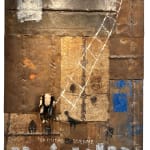




J. Roberto Diago Cuban, b. 1971
203.2 x 152.4 cm
Further images
Juan Roberto Diago’s work from the series Aquí lo que no hay es que morirse is a visceral exploration of survival, suffering, and the human condition under extreme deprivation. This particular piece, crafted from metal remnants—recycled materials from makeshift houses constructed under bridges in Cuba—embodies both the resilience and tragedy of the country’s most marginalized populations.
The metal, which once served as scrap, now becomes the medium of expression, with the artist creating a collage and incorporating drawings directly onto the piece. A crude, burnt figure of a naked, headless mannequin stands against a backdrop of an intricate, yet incomplete, staircase—suggesting a desperate climb toward something, perhaps a fleeting hope or an impossible escape from the harsh conditions. The absence of the figure's head evokes an overwhelming sense of dehumanization, as if identity has been stripped away, while the nakedness of the body amplifies vulnerability and exposure to the rawness of the environment.
The title, Aquí lo que no hay es que morirse ("Here, what we don't have is death"), is profoundly ironic, indicating that survival, however difficult, becomes the most immediate priority in a place where material scarcity and social neglect are rampant. The figure, half-burnt, represents the human spirit that endures despite everything being stacked against it, while the missing head symbolizes the loss of self in a society that renders its citizens invisible, struggling to exist in the rubble of what was once a more coherent social structure.
Through this piece, Diago transforms everyday remnants of poverty into a powerful commentary on Cuba’s social realities. By using scrap metal and other materials from improvised shelters, Diago not only references the poverty-stricken living conditions but also gives voice to those often relegated to the periphery of society. The piece becomes an artifact of survival, a reminder that life, however fragmented and broken, persists in the face of systemic neglect and hardship.





